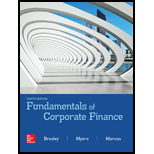
Concept explainers
a)
To determine: The price of 4-year bond if the bond has a yield to maturity of 9%.
Yield to maturity (YTM) is the overall return anticipated on a bond throughout its maturity period and it is considered as a long-term bond yield and represented as an annual rate.
a)
Explanation of Solution
Computation of price of the bond is as follows:
Therefore, the price of the bond is $967.60.
b)
To determine: The price of 8-year bond if the bond has a yield to maturity of 9%.
b)
Explanation of Solution
Computation of price of the bond is as follows:
Therefore, the price of the bond is $944.65.
c)
To determine: The price of 30-year bond if the bond has a yield to maturity of 9%.
c)
Explanation of Solution
Computation of price of the bond is as follows:
Therefore, the price of the bond is $897.26.
d)
To determine: The price of 4-year bond if the bond has a yield to maturity of 7%.
d)
Explanation of Solution
Computation of price of the bond is as follows:
Therefore, the price of the bond is $1,033.87.
e)
To determine: The price of 8-year bond if the bond has a yield to maturity of 7%.
e)
Explanation of Solution
Computation of price of the bond is as follows:
Therefore, the price of the bond is $1,059.71.
f)
To determine: The price of 30-year bond if the bond has a yield to maturity of 7%.
f)
Explanation of Solution
Computation of price of the bond is as follows:
Therefore, the price of the bond is $1,124.09.
g)
To determine: Whether the long-term bonds more or less affected than short-term bonds by a rise in interest rates.
g)
Explanation of Solution
From the computation of sub parts (a), (b), and (c), it is clear that the long term bonds are high sensitive with respect to changes in interest, regardless of the interest rate directions.
h)
To determine: Whether the long-term bonds more or less affected than short-term bonds by a rise in interest rates.
h)
Explanation of Solution
From the computation of sub parts (d), (e), and (f), it is clear that the long term bonds are high sensitive with respect to changes in interest, regardless of the interest rate directions.
Want to see more full solutions like this?
Chapter 6 Solutions
Fundamentals of Corporate Finance
- Muskoka Tourism has announced a rights offer to raise $30 million for a new magazine, titled ‘Discover Muskoka’. The magazine will review potential articles after the author pays a nonrefundable reviewing fee of $5,000 per page. The stock currently sells for $52 per share and there are 3.9 million shares outstanding. Required What is the maximum possible subscription price? What is the minimum? If the subscription price is set at $46 per share, how many shares must be sold? How many rights will it take to buy one share? What is the ex-rights price? What is the value of a right?arrow_forwardNorthern Escapes Inc. has 225,000 shares of stock outstanding. Each share is worth $73, so the company’s market value of equity is $16,425,000. Suppose the firm issues 30,000 new shares at the following prices: $73, $69, and $60. What will the effect be of each of these alternative offering prices on the existing price per share?arrow_forwardNeed answer correctly.arrow_forward
- Muskoka Tourism has announced a rights offer to raise $30 million for a new magazine, titled ‘Discover Muskoka’. The magazine will review potential articles after the author pays a nonrefundable reviewing fee of $5,000 per page. The stock currently sells for $52 per share and there are 3.9 million shares outstanding.arrow_forwardSs stores probarrow_forwardHenrietta’s Pine Bakery Corporation would like to raise $75 million to finance its expansion into new markets. The company will sell new shares of equity via a general cash offering to raise the needed funds. If the offer price is $15 per share and the company’s underwriters charge a 6% spread, how many shares need to be sold?arrow_forward
 Essentials Of InvestmentsFinanceISBN:9781260013924Author:Bodie, Zvi, Kane, Alex, MARCUS, Alan J.Publisher:Mcgraw-hill Education,
Essentials Of InvestmentsFinanceISBN:9781260013924Author:Bodie, Zvi, Kane, Alex, MARCUS, Alan J.Publisher:Mcgraw-hill Education,

 Foundations Of FinanceFinanceISBN:9780134897264Author:KEOWN, Arthur J., Martin, John D., PETTY, J. WilliamPublisher:Pearson,
Foundations Of FinanceFinanceISBN:9780134897264Author:KEOWN, Arthur J., Martin, John D., PETTY, J. WilliamPublisher:Pearson, Fundamentals of Financial Management (MindTap Cou...FinanceISBN:9781337395250Author:Eugene F. Brigham, Joel F. HoustonPublisher:Cengage Learning
Fundamentals of Financial Management (MindTap Cou...FinanceISBN:9781337395250Author:Eugene F. Brigham, Joel F. HoustonPublisher:Cengage Learning Corporate Finance (The Mcgraw-hill/Irwin Series i...FinanceISBN:9780077861759Author:Stephen A. Ross Franco Modigliani Professor of Financial Economics Professor, Randolph W Westerfield Robert R. Dockson Deans Chair in Bus. Admin., Jeffrey Jaffe, Bradford D Jordan ProfessorPublisher:McGraw-Hill Education
Corporate Finance (The Mcgraw-hill/Irwin Series i...FinanceISBN:9780077861759Author:Stephen A. Ross Franco Modigliani Professor of Financial Economics Professor, Randolph W Westerfield Robert R. Dockson Deans Chair in Bus. Admin., Jeffrey Jaffe, Bradford D Jordan ProfessorPublisher:McGraw-Hill Education





